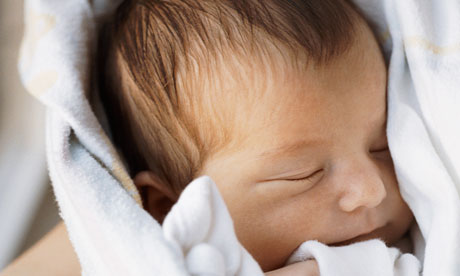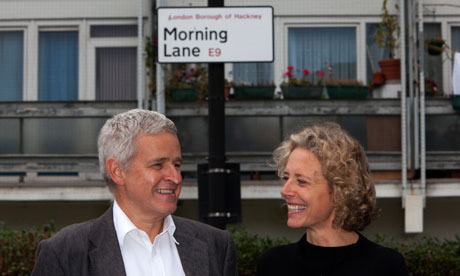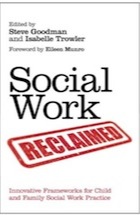Newborn babies in peril of abuse or neglect by 'toxic trio' parents
One in four babies at risk of abuse by being born into homes beset by domestic violence, mental health or drug problems

One in four babies is at risk of being killed or abused by being born into homes beset by domestic violence, mental health and dependency problems. Photograph: Lisa Spindler/Getty Images
At least one newborn baby in four is at high risk of death or abuse because one or both parents are beset by a "toxic trio" of domestic violence, mental health difficulties or substance dependency, according to the NSPCC, the only non-governmental body with statutory power to take children into care.
The charity calculates 198,000 babies in the UK are at high risk in a home beset by abuse, addictions and mental distress. The latter was by far the biggest risk, with 144,000 babies under a year old living with a parent with mental health issues. More than 93,000 babies have a problem drinker as one parent, while 50,000 are with one of their parents having used an "illegal drug" in the past year.
Though reasons for violence and abuse are complex, risk of homicide is greatest in a child's first three months. The NSPCC report, All Babies Count, says the perpetrators are "almost always parents".
The charity is starting an education drive aimed at reaching parents of 80,000 newborns over two years in 12 hospitals, using work in the US which cut hospital admissions by 40%. It is also testing an Australian model of teaching early parenting that cut risk of child harm for drug addicted parents.
A child's "frailty and total dependence" have to be taken into account when judging what constitutes neglect or violence, said the charity, but its analysis of 130 serious case reviews (investigating the death of a child) showed almost 75% had one or more of a "toxic trio" in a parent of mental illness, substance misuse, and domestic abuse as a significant factor. Maltreatment risk, especially neglect, is much higher in "trio" than in "normal" families"; the worst outcome is non-accidental head injury (NAHI), or "baby shaking syndrome", the most common cause of death or long term disability in such cases.
The report also says such conditions mean babies' life chances are worse for future learning, behaviour and health. In New Zealand a study found that, at age 15, a child with at least one problem-drinking parent was more likely to have "mood disorders, depression, anxiety, substance misuse and behaviour problems".
The government welcomed the campaign and its "innovative services". Iain Duncan Smith, work and pensions secretary, said: "At birth, 25% of a child's brain is formed, but already by the age of three, it is 80% formed. So intervening early to prevent harm is absolutely crucial."
Children in danger from violent fathers 'due to social services failures'
Almost 90% of men guilty of domestic violence remain in close contact with their children without supervision, report finds

Working With Risky Fathers is first report into involvement of chidren's services with domestically abusive fathers. Photograph: Dani Rodriguez / Alamy/Alamy
Children are being exposed to extreme danger because social services are failing to prevent or monitor contact with their violent and abusive fathers.
Almost 90% of men guilty of multiple instances of domestic violenceremain in close contact with their children despite local authorities failing in the majority of cases to conduct sufficient assessment into the risk they represent.
Working with Risky Fathers, the first study into children's services involvement with domestically abusive fathers, looked mainly at men living outside the family home.
"Really scary, violent fathers are routinely falling through the gaps in children's services, putting children who have already been raised in homes where domestic violence was present, at risk of further physical and emotional harm," said Cathy Ashley, chief executive of the Family Rights Group (FRG).
Launched today by the FRG and the Parenting Fund, the report found that 88% of the men surveyed continued to have contact with their children despite often long histories of domestic violence.
But the report also found an overwhelming lack of detail in the assessments of the risk these men presented to their children. In 46% of cases, for example, the birth fathers' phone number was not on the files. In over 60% of cases, the survey found that the father's parenting capacity was simply 'not known'.
The report surveyed three local authorities' case files of perpetrators of domestic abuse over 11 years. The fathers were frequently guilty of more than six separate reported incidents of domestic violence. Many adult victims had been pregnant during at least one of the attacks.
"If you don't assess these men, you don't know which are the seriously dangerous ones who could harm their children if given access," said Ashley.
The report also found that of the minority of domestically abusive men who did have their parenting assessed, just 26% were offered a place on a domestic violence perpetrator programme.
"There are many reasons why these men are not being properly assessed or treated," said Ashley. "Not only are these scary men but children's social services employ a largely female workforce that hasn't been trained to deal with such intimidating situations. Added to which, there simply aren't enough domestic abuse perpetrator programmes to send them to."
Ippo Panteloudakis, a manager at Respect, the membership association for domestic violence perpetrator programmes, say there are around 35 such programmes in the UK. "Men commonly have to travel hundreds of miles to access help," he said. "What happens more often is that local authorities use inappropriate alternatives or, frequently, no alternatives at all."
Ashley said the report highlights the fact that the onus of child protectionsocial work continues to be on the mother to protect the child, even when she is a victim of domestic abuse.
The report, however, also found that non-resident fathers not guilty of domestic violence can find themselves ignored when they try to warn social services of risks, such as those presented by a mother's neglect or her new partner.
"Children's services are failing to engage with fathers who are the protective factor for children at risk," said Ashley. "We found three cases where the birth father had tried to alert children's services about the child – including the Peter Connelly case, where social workers failed to recognise the significance or assess the mother's new partner."
How Hackney reclaimed child protection social work
Is a model of social work that radically transformed child protection in one borough about to go mainstream?

Steve Goodman and Isabelle Trowler, who overhauled the way that social workers dealt with families in Hackney. Photo: Graham Turner for the Guardian
It reads like the Christmas wishlist of every council's children's services department: a 40% reduction in the number of children going into care, staff sick leave halved, being hailed as an example of best practice in an independent government review, and costs cut. All were achieved by Hackney council's children's services, in east London, under the leadership of Steve Goodman and Isabelle Trowler.
The pair – who met in 2005 when Goodman had recently been appointed deputy director of children's services and Trowler was a newly arrived assistant director of children's social care – are credited with transforming children and family social work practices in the borough and influencing government policy. They have written a book about their model of social work and last year set up a social enterprise to help other councils adopt it; they have since left Hackney.
When they arrived in the borough, they found many social workers simply lacked the skills required to do the job, both because of the quality of people entering the profession and inadequate training. The system had become so bound up with tick-box bureaucracy that social workers spent more time filling in forms than working with children and families.
"Children were going into care who, if you did the job properly, wouldn't need to," says Trowler. But what was happening in Hackney reflected what was happening across England, adds Goodman.
Every inquiry into a child death (such as those following the killings of Victoria Climbié and Peter Connelly), has made the system more inflexible and defensive, Goodman and Trowler believe. "Child protectionis about assessing and managing risk. If you are risk-averse you can't do the job," says Goodman. "Instead of working with the family you just take the child away."
Trowler adds: "You can follow the rules, but it won't necessarity help the child … it's conveyor-belt social work."
Like-minded
So the like-minded colleagues set about trying to change things. "At first, we tried to work within the traditional model," explains Goodman, "but we kept realising we were in a cul-de-sac." By 2006, they had realised that "whole-system change" was called for. The result was a new model they called Reclaiming Social Work (RSW), which won the support of the council's chief executive and elected leaders."People thought we were barmy," says Trowler, "to think we could make such huge changes."
But Goodman, 55, and Trowler, 44, were energetic, determined and organised – and complemented each other perfectly.
Goodman grew up on a council estate in Luton with direct experience of social workers coming into the house. He says that seeing social workers work with his own family "formed quite a lot of my values about how we should approach families. Social workers may not feel very powerful but when we knock on someone's door, [to them] we seem very powerful. We need to be aware of that and be respectful. That does not detract in any way from our responsibility to protect children." He started his career 30 years ago in Leicester.
Trowler has worked for various London boroughs and has a master's degree in social work and social policy from the London School of Economics.
"There are no quick fixes," Trowler insists. "RSW is an agenda for change over three to five years" and it needs to be implemented "with military precision" in order to be effective. In budgetary terms, it requires a bit of extra money upfront but costs quickly begin to fall.
A residential placement for a child costs about £2,500 a week, points out Goodman, so with fewer children taken into care under RSW it doesn't take long to recoup the costs of extra training and family support services.
In Hackney, numbers of children in care have declined steadily from 470 in 2004 (not especially high compared with areas of similar deprivation) to about 270 now. Costs are down by 5%.
Few of Hackney's original social workers from 2006 got posts in the new system. Trowler and Goodman introduced verbal reasoning and other pre-interview tests for job applicants and took over the interviewing themselves. At first, they say, it was hard to attract good candidates – the borough had a terrible reputation – but as word got around about what they were doing, that changed.
Staff learn systemic approaches – looking at all the key relationships in a child's life and how they can be improved to create the best outcome for the child.
Another essential element to RSW is the working culture in the organisation. Goodman believes that there must be an environment that is energising and in which thinking and creativity are encouraged, where there is support and good humour and mistakes are accepted and put right as quickly as possible. There also needs to be real understanding for the families. "Culture trumps everything," he says.
So what does RSW mean for families? Goodman recalls a family of six children who had been on social services' lists for years because of neglect. "The children were going to school dirty and smelling of urine, they were underfed and the parents were unco-operative," he says. "Eventually, Hackney got care orders for all six children. The older ones kept running away from foster placements. The new unit worked with the family, and the older children were able to go home."
Trowler cites a mother with learning difficulties. "She was really struggling. She was doing her best and the relationships in the family were warm and loving, but she couldn't manage the practicalities of looking after five children. Usually, these kids would be removed, but we decided instead to invest in family support, practical help – long-term, so the children could stay at home."
An independent review of child protection for the government by LSE professor Eileen Munro earlier this year highlighted RSW as an example of best practice.
Beating a path
As a result, councils are beating a path to the door of the pair's social enterprise, Morning Lane Associates – named after the road in Hackney where the former council employees worked.
Morning Lane Associates already has contracts with 16 councils, including Cambridgeshire, which is about to implement the RSW model. "They have just recruited their first 26 consultant social workers to start work in January," says Goodman, "and they will make it work. They understand the culture change."
Spot the difference
Traditionally, individual social workers have a caseload of perhaps 15 children (depending on the type of case). A team manager oversees often seven or eight social workers – and so probably more than 100 at-risk children, many of whom they will not have met.
In the RSW model, children are allocated to a unit headed by a consultant social worker who is both manager and practitioner. They lead another social worker, a children's practitioner, a clinical specialist and a unit co-ordinator. The co-ordinator undertakes all administration.
Weekly meetings are held to discuss the families before deciding how to move forward. Responsibility for what is to be done is shared by the unit. There is more trust and delegation of responsibility, with a social worker who sees the need to spend, say, £20 on something for a family, having no need to delay for managerial approval, for example.
If a family is difficult, two staff members can visit together. If a staff member is away, there is always another who knows the family's story. During a crisis, several informed people can address it at once.

No comments:
Post a Comment